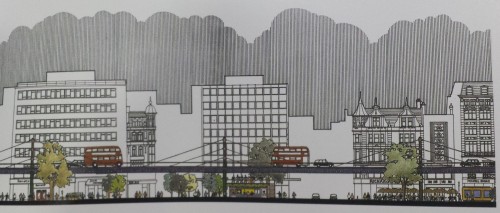Thirty years ago, a plan was shown off to replace the main road running along Oxford Street with a giant flyover.
Unlike the concrete eyesores that were put up in the 1970s such as the Westway and Hammersmith Flyover, this was to be built with pedestrians in mind — indeed, its entire purpose was to permit the pedestrianisation of Oxford Street.
Proposed by Bryan Avery — the architect who later designed the refurbished London Transport Museum — the plan was for a three-lane elevated road to run the length of Oxford Street, about 2 stories above the street level.
Underneath would have been paved over and given to pedestrians, with escalators up to the elevated street for bus stops and the like.
The scheme was estimated to cost £47 million (in 1982 prices) and some of the funding would have come from leasing out the new space under the road to smaller shops. Imagine a long line of food and coffee bars. In addition, one of the architect’s trademarks would have been a glass canopy between the road and the shops, effectively turning the entire of Oxford Street into an indoor shopping mall.
The elevated road would have dipped down to street level at Oxford Circus for the interchange, with pedestrians themselves being elevated over the road within a glass dome.
As Byran Avery said, “all the traffic could be accommodated exactly as existing whilst also increasing the pedestrians’ realm dramatically.”
Initially welcomed by both the Oxford Street Association and Westminster Council, following a presentation, concerns were raised about the viability of the scheme.
One of the big arguments against it, apart from cost, was that it didn’t deal with road pollution. The doubts meant that without further financial support, it wasn’t possible to expand the concept into a fully fleshed out proposal, so it remains unbuilt.
—
Every decade or so, talks emerges of an attempt to pedestrianise Oxford Street.
Back in the 1960s, a report by Professor Sir Colin Buchanan suggested dropping the road slightly into a shallow depression and raising the shopping level up by 20 feet. The report also dismissed its own finding, noting that it was already too late for such a radical rebuilding of the street, and that banning the motor vehicle entirely may be the only solution.
Most recently, it was suggested that a light rail, or tram could replace the traffic congestion on Oxford Street. Previous suggestions have included long travolators along the road, a monorail, or even an elevated walkway along the streets with entrances to the shops on the 2nd floor.
It’s probably a question of when rather than if, the notion of a pedestrianised Oxford Street ceases to be “Unbuilt London”, but what shape it will take is anyone’s guess.
Sources:
Planning in London, Oct 2012
The Times, Dec 24th 1983
Fragments of Wilderness City, Edwin Heathcote, 2011
Traffic in Towns: A Study of the Long Term Problems of Traffic in Urban Areas, Colin Buchanan









Was there any provision for cyclists? I can’t see any. Planners seldom ride bikes.
Why would you think there wasn’t (or indeed, was) any provision for cyclists based on a couple of simple sketches?
You can’t come to that sort of detailed conclusion from so thin a source of information.
The buildings haven’t changed since the first diagram was drawn – it seems to show the stretch between Duke St. and just-past James St.
My suggestion is is for a Wuppertal style monorail from Holborn to Marble Arch, with stations on the first floors of whichever shops deign to fund them.
Like the Loop in Chicago but much more fun